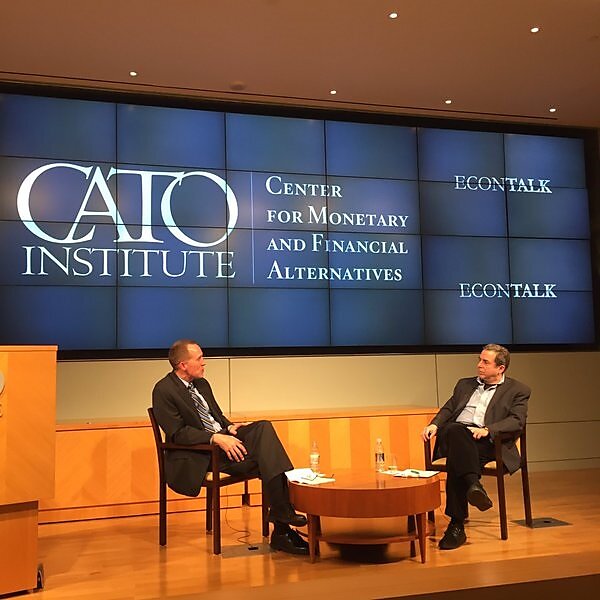Roberts began by asking Beckworth to tease out the difference between commonly heard explanations of the crisis and his own. Most pundits analyzing the causes of the Great Recession zero-in on the housing sector. They note the boom in housing prices, mortgage debt, and securitized financial bets. The decline in housing prices thereby caused a panic that spread to the real economy. Some blame government policy for the housing boom and bust, others a “financial sector run amok,” but either way the centrality of housing is rarely disputed.
Beckworth by contrast argues that housing only caused a mild downturn. Blame for that downturn becoming a Great Recession rests with the Fed. Beckworth points out that aside from the housing sector the economy grew from 2006 through the early part of 2008. The fall in housing prices in early 2006 and beginnings of financial turmoil in early 2008 did not cause severe economy-wide trouble. So what turned an isolated contraction into the Great Recession? As Beckworth puts it “what’s the one asset held on every book? … [I]f you want to simultaneously mess up an entire economy, somehow affect the demand or supply for money.”
According to Beckworth, the Fed made three distinct mistakes: (1) it sterilized emergency lending, (2) held the fed funds rate target at 2.25% for an approximate five month period from April-October 2008, and (3) paid interest on reserves.
Beckworth discusses the Fed’s interest rate policy in the most detail, arguing that the Fed was far too concerned with potential inflation. He points out that based on FOMC minutes and Ben Bernanke’s memoir the Fed was just as concerned with potential future inflation in September ’08 as it was with the real economy, and that as late as August ’08 Fed officials were still talking about the possibility of a rate hike.
Could cutting the overnight rate 2.25 points (between the Fed’s target and 0) have helped? Beckworth emphasizes that changes in the supply of money do not have a 1:1, consistent, effect on output. But in the context of the weakened 2008 economy the failure to continue lowering rates was particularly painful. Beckworth compares the heightened importance of monetary policy in 2008 to antibiotics. When a patient has pneumonia, properly administering antibiotics is much more important than when a patient has no bacterial infection at all.
Beckworth also points to the Fed’s consideration of raising rates in summer ‘08 as support for his arguments on the significance of the Fed’s mistakes. Futures contracts, notably, implied market expectations for the fed funds rate was as high as 3.25% in the summer of 2008, further illustrating the Fed’s target rate was well above the clearing or natural rate: the rate needed to keep output near its potential level.
“How might the Fed do a better job in future at keeping interest rates at the natural level?,” Roberts asks. Beckworth responds that if the Fed targets nominal spending, rather than interest rates, it does not have to worry about knowing the natural rate. Stabilizing spending, and then “letting the real side [of the economy] determine how that spending gets allocated” would ensure that interest rates move freely so that credit markets clear. As part of a more general pitch for nominal spending targeting, Beckworth argues that this system would ensure a more “systematic, predictable, and rules based” Fed. Beckworth mentions Scott Sumner’s proposal for the NGDP target to be set by a futures market. According to Beckworth, such a proposal would allow for a completely automatic, non-discretionary monetary policy.
In the concluding moments, Roberts and Beckworth discuss the actual possibility for real change at the Fed. While Beckworth makes the caveat that bureaucratic institutions like the Fed are rather adept at resisting change, he notes that there have been positive signs for supporters of NGDP targeting. Notable economists Christina Romer and Michael Woodford have endorsed the idea, for example. While a complete change in our monetary system might be far off, realistically, Beckworth envisions the possibility of raising his cane in triumph at a retirement home when that time comes.
Listen to the full podcast here, and or watch video, including a question and answer session not included in the official podcast here.
Disclaimer
This post was originally published at Alt‑M.org. The views and opinions expressed here are those of the author(s) and do not necessarily reflect the official policy or position of the Cato Institute. Any views or opinions are not intended to malign, defame, or insult any group, club, organization, company, or individual.
All content provided on this blog is for informational purposes only. The Cato Institute makes no representations as to the accuracy or completeness of any information on this site or found by following any link on this site. Cato Institute, as a publisher of this article, shall not be liable for any misrepresentations, errors or omissions in this content nor for the unavailability of this information. By reading this article and/or using the content, you agree that Cato Institute shall not be liable for any losses, injuries, or damages from the display or use of this content.


